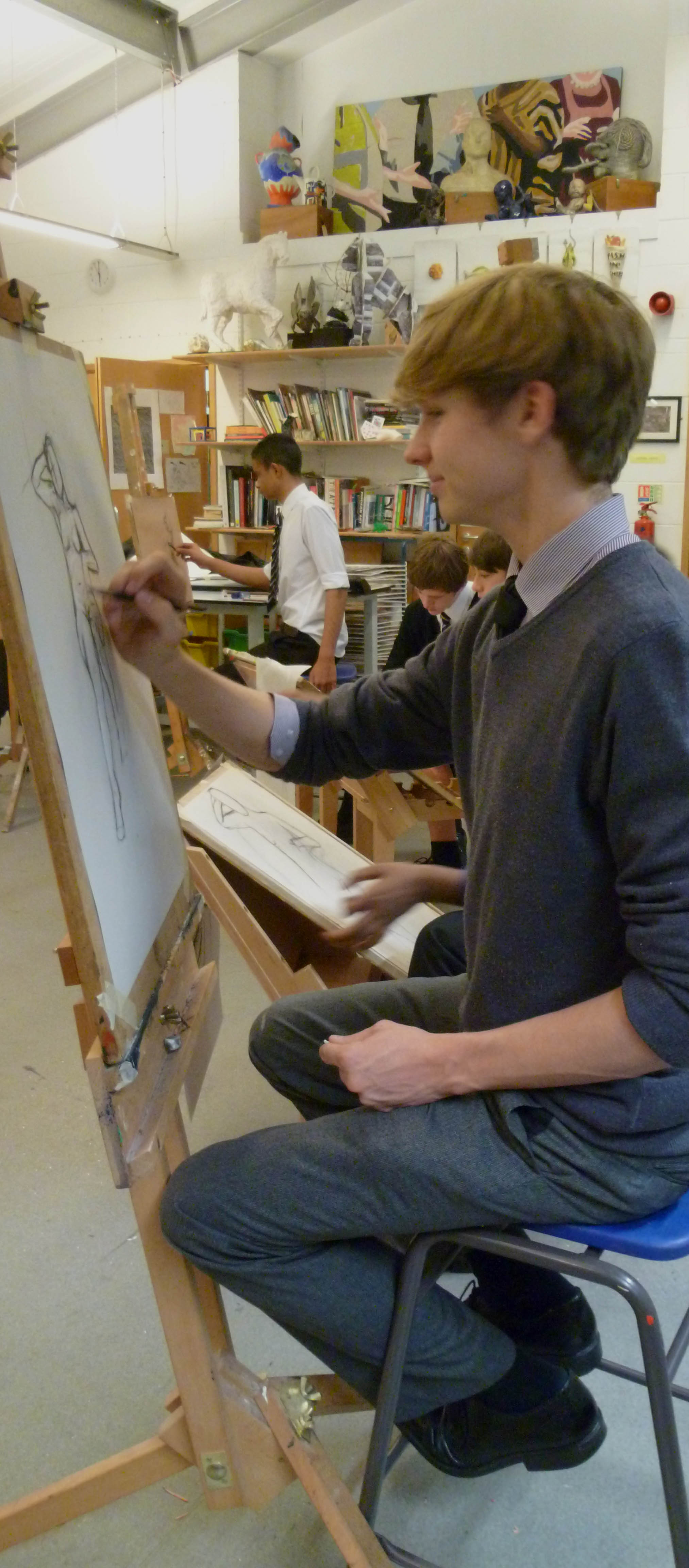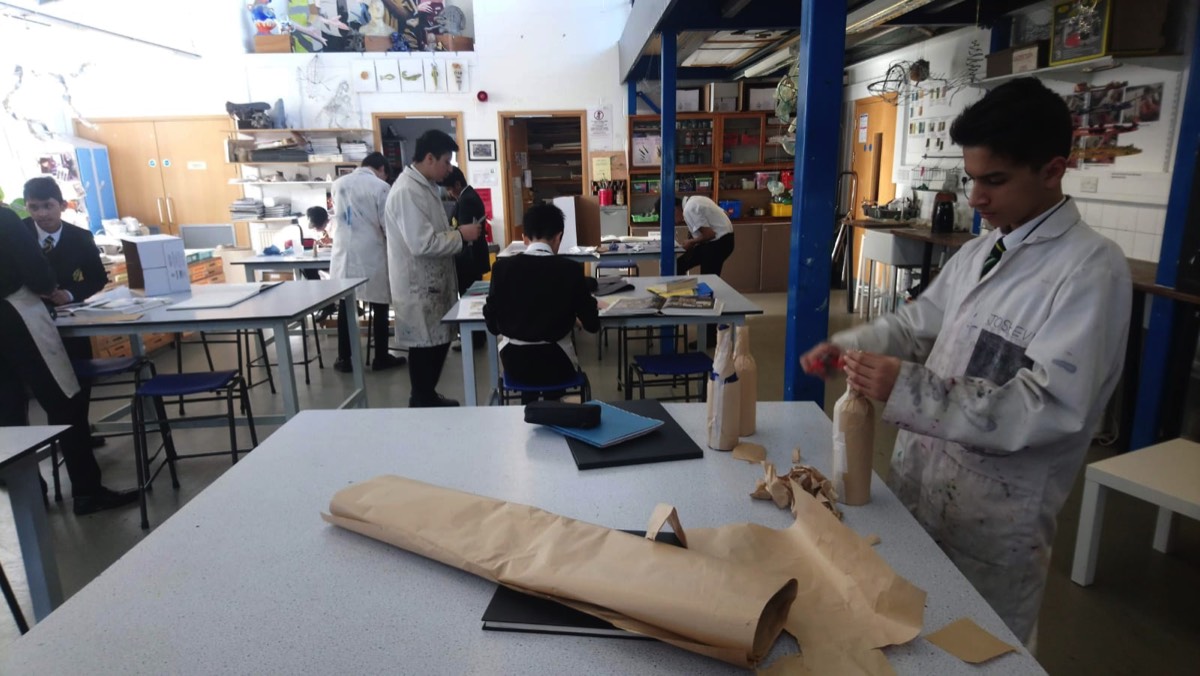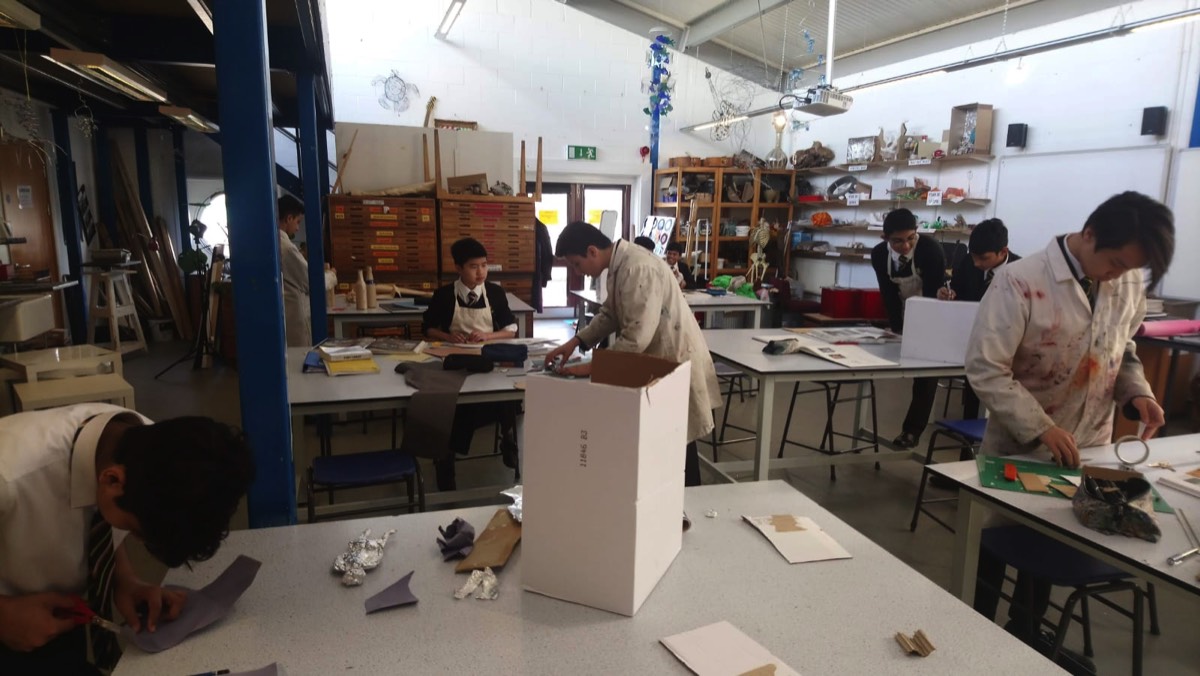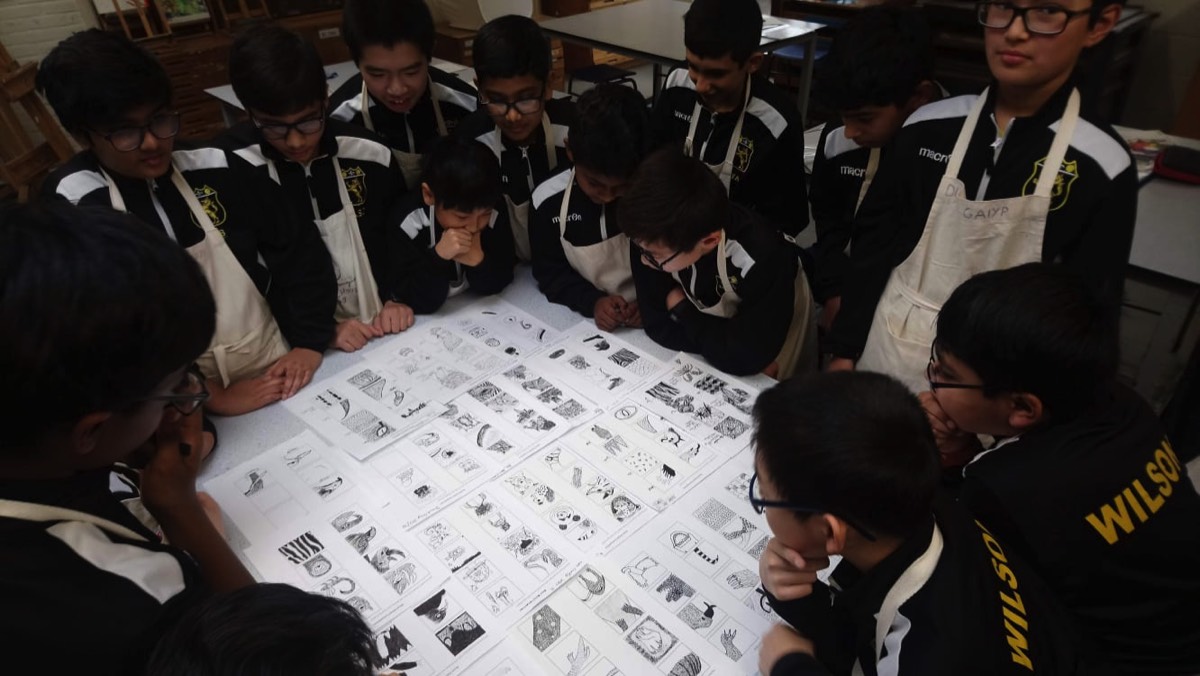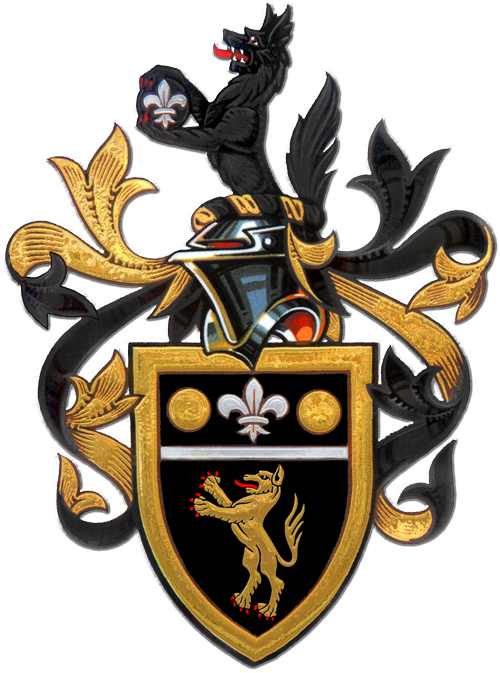Art
The Art and Design department at Wilson’s School is a vibrant and integral part of the curriculum. All pupils study Art and Design for two years at Key Stage 3, and can then opt for GCSE and A Level. At GCSE, students follow the Eduqas specification, and at A Level, they choose either the Eduqas Fine Art or Art and Design pathway.
Lessons are practical, engaging, and foster independent learning. Trips to galleries, exhibitions, and cultural sites complement classroom work. These experiences help students develop visual awareness and showcase their work.
The department encourages creativity, aiming to enhance practical skills using traditional and modern techniques, build confidence in drawing, and foster an understanding of the creative process. By nurturing these skills, we aim to prepare students as confident, creative thinkers, equipped for future industries.
Our Staff
Miss Waterhouse (Head of Department)
Mr Coop (Deputy Head)
Ms Russell
Mr Kennish (Technician)
Curriculum
Year 7 & 8: Outline Programme of Study
Students follow a two-year Key Stage 3 curriculum in Art and Design, based on the National Curriculum programme of study. Key Stage 3 Art and Design therefore engages, inspires and challenges pupils, equipping them with the knowledge and skills to experiment, invent and create their own works of art, craft and design. Students are introduced to Art as a process. As pupils progress, they should be able to think critically and develop a more rigorous understanding of art and design. Pupils develop core skills during the development of their work and these are assessed in line with the school’s reporting policy. For example, students could be required to:
- Produce artifacts, exploring their ideas through the appreciation of representational and non-representational art.
- Develop their skills using a variety of media and techniques, including taught and experimental uses of materials, to create outcomes.
- Drawing is at the heart of all Art and Design activities and is taught regularly as a discipline for visual communication.
- Understand the meanings of new technical terminology and use it to evaluate their own work and analyse the work of others.
- Develop an understanding of Art and Design throughout history in context to the development of their own work.
- Understand the process of experimentation, evaluation and refinement of materials and techniques.
KS3 Core Concepts
| 1 Sources |
Critically investigate and develop ideas from sources EXCEEDING: Development of a diverse range of independent and problem-solving ideas through sequential thinking and imaginative leaps. An exceptional critical understanding of the context of own ideas and the sources that have informed them. SECURE: Development of a range of ideas through sequential thinking. A good critical understanding of the context of own ideas and the sources that have informed them. DEVELOPING: Ideas consolidated too early with some appreciation of sequential development. A limited critical understanding of the context of own ideas and the sources that have informed them. |
| 2 Materials |
Refine techniques through experimentation with materials EXCEEDING: Recognises the full potential and limitations of processes with an insightful review, refinement and evaluation of materials. Demonstrates refined technical ability. SECURE: Demonstrates an understanding of the potential and limitations of processes with some review, refinement and evaluation of materials. Demonstrates a good technical ability. DEVELOPING: Materials used in an obvious and limited way. Development restricted as a result of experimentation and evaluation being abandoned too early. |
| 3 Outcomes |
Realise outcomes and observations using the formal elements EXCEEDING: Outcomes demonstrate sophistication from conception/observation to realisation. Work is intuitive, original and shows a full command of the formal elements and concepts. SECURE: Outcomes are well constructed and work has developed a personal identity. Outcomes and observations show a good command of the formal elements and concepts. DEVELOPING: Outcomes show an emerging sense of own style, but tend to be methodical. Outcomes and observations show a limited command of the formal elements and concepts. |
| 4 Evaluation |
Consider, discuss and evaluate own and others’ work EXCEEDING: Evaluation is insightful and reflective, showing independence and maturity in considering both own and others’ work. Confidently articulates strengths, weaknesses, and intentions, with reference to formal elements, techniques, and contextual/historical influences. Feedback is acted upon thoughtfully and meaningfully. SECURE: Offers thoughtful evaluation of own and others’ work, identifying strengths and areas for development with increasing clarity. Can make relevant connections to formal elements and techniques. Responds constructively to feedback to improve outcomes. DEVELOPING: Comments on own or others’ work are general or descriptive rather than analytical. Struggles to identify specific strengths or areas for improvement. Limited ability to act on feedback or relate evaluation to techniques or intentions. |
Key Stage 4
Key Stage 4 (Years 9-11)
Examination Board
The Art & Design department follows the broad- based specification of Art, Craft and Design from the Eduqas Art and Design GCSE.
The course consists of two internally assessed and externally moderated components:
- Component 1: Personal Portfolio
60% of the qualification - Component 2: Externally Set Assignment
40% of the qualification
Years 9-11: Outline Programme of Study
Art is the only completely practical subject offered at Wilson’s. The Art GCSE is a key step in the ladder of progressing from A level Art to degree level courses such as Architecture and other Art and Design courses.
The syllabus is unendorsed which means there is a broad approach to using specialist materials and investigations can follow a personal nature. 2D design, 3D design and digital media are all built into the course helping pupils to specialise in areas that are best suited to them.
During the three years of the course, there will be several visits to museums and galleries. There are no essays required but sketchbooks need to be critically annotated.
Art GCSE covers a range of activities and in-depth assignments. You will have the chance to experiment with different media to explore your strengths and preferences.
There will be a wide range of options within the different endorsements, or you may choose to work in several areas. Whatever you choose, the main aim of the course is to develop your visual language skills and for you to build a comprehensive portfolio of work to progress to further courses.
Key Stage 5
Examination Board
The Art & Design department follows the Eduqas A Level Fine Art or Art and Design specifications.
The course consists of two internally assessed and externally moderated components:
- Component 1: Personal Portfolio
60% of the qualification - Component 2: Externally Set Assignment
40% of the qualification
A Level: Outline Programme of Study
The course aims to engage with and explore the visual arts through producing personal practical work. Outcomes are therefore not prescribed and each candidate has a great deal of autonomy in developing work that they find interesting and inspiring. The Art staff work closely with the A-level candidates in helping them develop their work successfully and in fulfilling the highest examination criteria. The syllabuses offered are Fine Art and Art and Design.
All students are encouraged to work in a broad range of materials and approaches. These include 2D and 3D work as well as photographic and film-based media. Students interested in illustration and graphic communication can be entered for the Art and Design specification that allows for a greater variety of pathways.
Component 1: Personal Portfolio
In Year 12, the pupils develop their skills across the assessment objectives as part of Component 1.
In Year 13 the pupils build upon their independent creative journeys as part of Component 1. This component allows pupils opportunities to generate and develop ideas, research primary and contextual/historical sources, record practical and written observations, experiment with media and processes, and refine ideas towards producing personal resolved outcome(s).
The written personal study, which is an assessed element of Component 1 in Year 13, is an integrated piece of writing which must comprise a minimum of 1000 words of continuous prose.
Component 2: Externally set assignment
This component allows pupils opportunities to generate and develop ideas, research primary and contextual/historical sources, record practical and written observations, experiment with media and processes, and refine ideas towards producing personal resolved outcome(s) in response to an externally set theme.
Departmental and Co-Curricular, Trips and Enrichment Opportunities
Opportunities for enriching the students cultural and practical experiences occur throughout the school year -
- KS3 students can get involved with a variety of practical activities in Art Club.
- In KS4, visits to the National Portrait Gallery, the Royal Academy, Tate Britain and Tate Modern, provide opportunity to enrich the students' portfolios of work.
- At A level, students are tutored in life drawing as well as experiencing world-renowned artists discussing their work at Art in Action.
- The ARTiculation Prize is organised annually, where students are invited to each deliver a 10-minute presentation to an audience about a work of art, architecture, or an artefact of their choice.
Examples of marked work
See below for examples of marked work which demonstrate the level of work and ‘green pen’ engagement required to maximise progress in each Key Stage. Whilst we expect students to engage with this positively and if necessary, seek clarification from teachers, please be assured that in-lesson support is always available.
